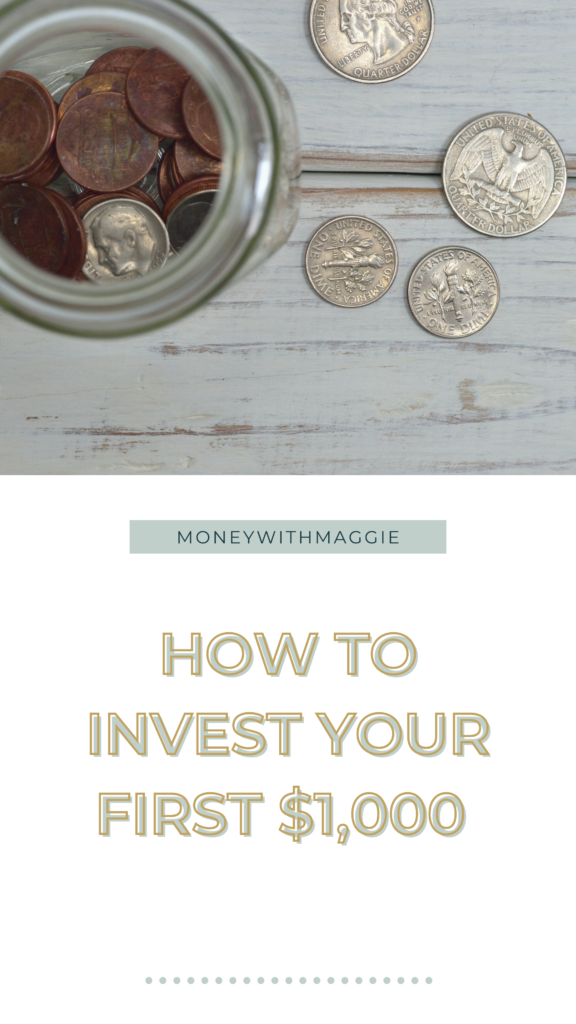Are you wondering how to invest your first $1,000? I can help you learn how to diversify your money into investments depending on whether you want to take an aggressive or conservative approach. Learn about the 80/20 strategy for investing.

Woohoo! You saved up your first $1,000 to put into investments. And as a beginner, you probably have a ton of questions. It can seem overwhelming at first, but I’m here to help you in the process of investing that $1,000.
There are a few things to keep in mind when investing your money:
- Where to go to start investing your money
- How to divide up your money into different investments
- How to review and make adjustments when needed
Before getting into the strategizing, I suggest having your high-interests debts paid off and an emergency fund that’s readily available to you. You just never know what can happen with the market and should always be prepared for when it goes down.
Where to Invest Your Money
When it comes to investing money you have to start by opening an account so that you have somewhere to buy into investments. If you’re a beginner, I suggest opening an account with Fidelity because they allow you to do fractional investing, which means you don’t need the full dollar amount to purchase stocks. They also have a bunch of great perks for beginners. Otherwise, Vanguard is also a good place to open an account, but you can go with any firm that you prefer.
BUT I really don’t recommend using Robinhood or anything that is “app-only” because they tend to gamify investing and incentivize you to buy into “trendy” stocks. This won’t help bring you long-term success. And when you compare Robinhood to other firms, you can see clearly see that even their S&P 500 does significantly worse, which is an indicator that they don’t help users be successful on that platform. They also don’t have a helpline to answer your questions right away.
How to Divide Up Money into Different Investments
I recommend following the strategy of putting 80% of your money into index funds and 20% into individual stocks. Individual stocks could be more risky investments that you want to dip your toes into and the 80% towards index funds would be your core portfolio that gives you a solid foundation to start with.
I’d say take the 80% of your $1,000, which is $800, and put it into 3 index funds and use your 20% in two individual stocks.
Aggressive Investors
You can be an aggressive investor when you are looking for more long-term results and have both the time and money to invest. With the 80/20 strategy, you want to invest $400 of your 80% bucket into a large cap index fund (like the S&P 500), $200 into a small/medium/small-mid cap fund, and the last $200 into an international small cap fund.
With your 20% bucket, you can either put it into 2 individual stocks or break it down to 4, but I wouldn’t divide it into more than that. It’ll get difficult to manage and you’ll just be replicating a basket of funds.
“Concentration builds wealth, diversification maintains it.”
Conservative Investors
If you can’t tolerate a large loss, which is a reality when investing in stocks, then you can go with a more conservative route. Take your 80% bucket and invest $400 into a large cap fund and the other $400 into bond funds or bond mutual funds. With your 20% bucket, you can still put it into individual stocks.
But if the idea of individual stocks is still too risky for your liking, then you don’t have to invest in them. You can take your entire $1,000 and invest them into 3 or 4 index funds for a safer investment.
Reviewing Your Investments and Making Adjustments
Now that you have a strategy in place, you can set up your accounts for recurring deposits toward your investments. Just look into your firm’s transfer section and connect your bank account if you haven’t already.
You only really need to review your portfolios annually. That one time a year will prevent you from being sucked into what they call “emotional investing.” Emotional investing is what causes a large chunk of investors to face major losses because they’re paranoid about what’s happening at all times and pull out their investments before they had a chance to make a gain.
Checking once a year will be enough for you to evaluate whether you should add more money to your investments or if you wanted to make some changes and reallocate your money elsewhere. Make sure that when you do your annual review, you’re making it a scheduled event. You don’t want to check into your portfolio as a response to what’s happening on the news.
This was a lot of information to take in and there are probably some lingering questions. Please feel free to reach out to me for help because that’s what I’m here for!

need help investing?
Let's Get Started Investing, Together.
Browse my best selling courses to get a solid foundation on how to start investing and preparing for your future!
PLEASE COMMENT BELOW